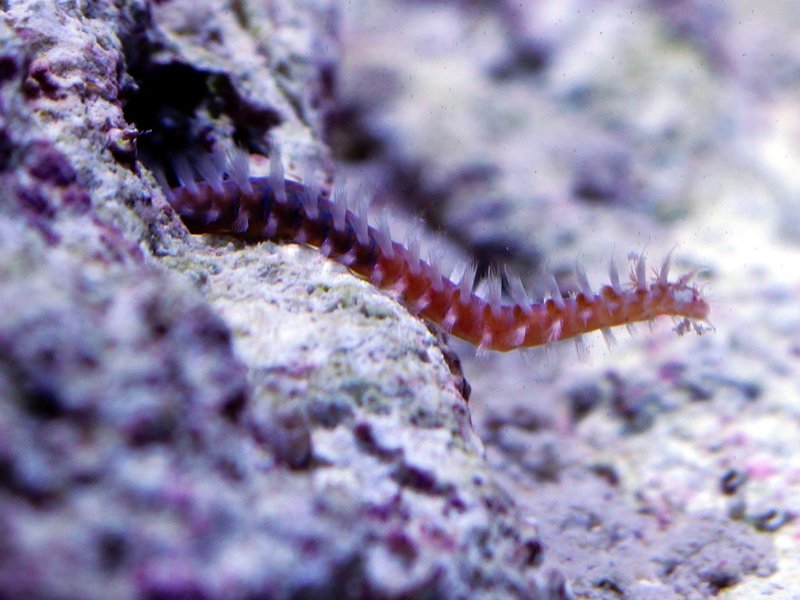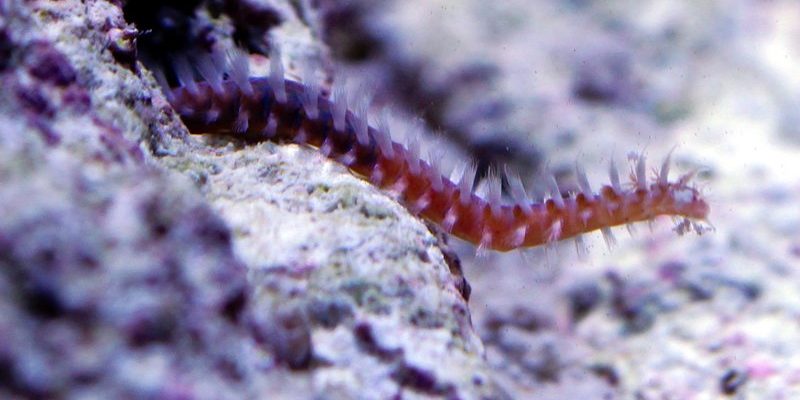
Think of your aquarium as a mini-ecosystem, complete with its own food chain and resident critters. Just like uninvited guests at a party, bristle worms can crash this environment. But before we panic, it’s essential to understand these creatures’ roles, their behaviors, and what makes them tick—after all, not all intruders are harmful.
What Are Bristle Worms?
Bristle worms are segmented worms belonging to the class Polychaeta. These inhabitants come in various colors and sizes, with some reaching several inches long. They’re mostly found in marine environments but can hitch a ride into your aquarium through live rock, sand, or even with new plants. Picture them as the cleanup crew of the ocean floor, munching on decaying organic material and dead marine life.
Here’s the thing: bristle worms have bristles or setae along their bodies, which can be a mixed blessing. While these bristles help them move around, they can also pose a problem. If you touch one, you might find yourself with a sting—an awkward reminder that some guests are better left undisturbed.
These worms play a role in your tank’s ecosystem by breaking down waste, but they can multiply quickly, especially in conditions that favor their survival. A few bristle worms are generally harmless, but when their numbers explode, they can become a nuisance.
How Do Bristle Worms Invade Your Aquarium?
Bristle worms often find their way into saltwater aquariums through a few sneaky routes. The most common method is via live rock, which is often used to create a natural habitat. When you introduce new rock or sand, it’s possible to unknowingly bring along a few of these critters.
You might be wondering, “Can’t I just check everything before adding it to my tank?” While you can inspect for visible worms, many are quite small or hide in crevices. It’s a bit like buying a mystery box—you may get a treasure or an unwelcome surprise.
Another way they sneak in is through new plants or decorations. If you have live plants, especially ones from the ocean, they could be harboring bristle worm eggs or even tiny adults. It’s all fun and games until you realize you’ve invited more guests than you intended.
Why Are Bristle Worms Considered Pests?
While bristle worms can help with aquarium cleanup, there’s a fine line between helpful and harmful. When their population explodes, they can start eating live coral, snails, or even small fish—definitely not ideal for a healthy tank.
Here are some signs that bristle worms are becoming a problem:
- Coral damage: If you notice your coral is being nibbled at or damaged, bristle worms might be the culprits.
- Decreased fish population: If your fish are disappearing or looking stressed, it could be due to bristle worm predation.
- Excess waste: An explosion in their numbers often results in more waste in your tank, which can lead to poor water quality.
The key to maintaining a balanced ecosystem is monitoring and controlling bristle worm populations before they get out of hand. Think of it as keeping your garden tidy—regular maintenance goes a long way.
Managing Bristle Worm Populations
If you’ve identified bristle worms in your aquarium and want to keep their numbers in check, there are several strategies you can employ. First and foremost, it’s essential to **maintain good water quality**. Bristle worms thrive in tanks with excess nutrients, so regular water changes can help keep their food sources in check.
Another effective method is to introduce natural predators. Certain fish species, like wrasses or some types of gobies, enjoy snacking on bristle worms. However, you’ll want to ensure these fish won’t harm your other tank inhabitants.
If you’re faced with a larger infestation, you might need to resort to traps. There are commercially available traps designed to catch bristle worms without harming other creatures in your tank. You can also create a DIY trap using a piece of food in a bottle and placing it in the tank overnight.
Preventing Bristle Worm Infestations
Prevention is always better than cure. Here are some simple tips to keep bristle worms from making your aquarium their home sweet home:
- Quarantine new arrivals: Always quarantine new rock, plants, or fish to minimize the risk of introducing pests.
- Avoid overfeeding: Keep your feeding habits in check. Overfeeding can lead to excess nutrients that fuel bristle worm populations.
- Regular cleaning: Make it a habit to clean the substrate and remove any decaying matter from the tank.
By staying vigilant and practicing good tank maintenance, you can keep your aquarium clean and bristle worm-free. Remember, it’s all about balance!
So, there you have it! Bristle worms might be a nuisance at times, but understanding them is half the battle. Whether they came in as unexpected guests or you’ve got one too many in your tank, knowing how to manage their presence can help maintain a thriving aquarium environment.
In the end, every aquarium has its quirks, and learning to adjust to them is all part of the experience. Keep an eye on your water quality, maintain good tank hygiene, and be mindful of your aquatic community. Happy fish-keeping!

